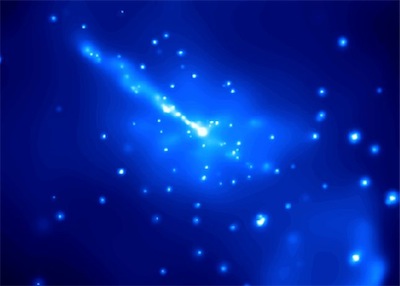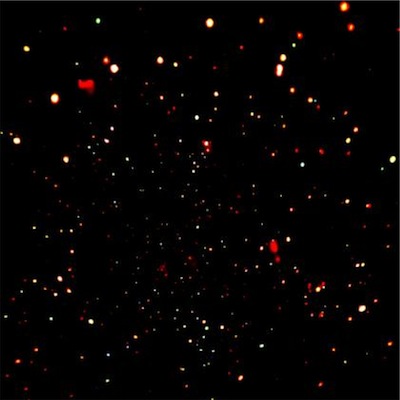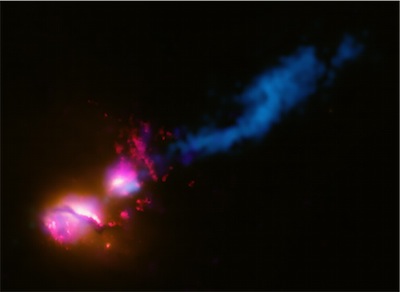He started with some basics. Escape velocity V is the square root of 2GM/R, where G is the gravitational constant, M is mass and R is the radius. So if you wanted to know how big a black hole with the mass of the sun would be, solve for R which is the square root of 2GM/c where c is the speed of light. You get a 3km radius, that's under 4 miles diameter.
A black hole will only suck in matter that's within 3 times radius of the event horizon. As matter is pulled into the black hole, it rubs together and via friction generates heat and light, particularly in x-rays. Other light is generated but x-rays are easy for us to see since few other things generate them.
Chandra is a spece telescope, like Hubble but sees x-rays. Here's the Chandra Deep Field-North image.
"The Chandra Deep Field North image (left) was made by observing an area of the sky three-fifths the size of the full moon for 23 days...More than 500 X-ray sources are present in this high-energy core sample of the early universe. Most of the sources are supermassive black holes located in the centers of galaxies. If the number of supermassive black holes seen in this patch of the sky is typical, the total number detectable over the whole sky at this level of sensitivity would be 300 million."
Super-Massive Black Holes (SMBH) are those found at the center of galaxies. They're much much larger than those formed from supernovas. He said the theory was that they formed from coalescing dark matter in the early universe. While it was unexpected, it seems there's a direct relationship between the size of a SMBH and the size of its galaxy.
As SMBHs spin, the matter that gets sucked into them forms a disk known as an accretion disk. As this matter is sucked into the black hole, some of it spins around it and is released in huge hot gas jets perpendicular to the disk. These can be hundred of thousands of light-years long and can generate huges amounts of energy. Here's an image of a gas jet in Centaurus A, shown in x-rays generating 1038 Watts.

Galaxy clusters are huge collections of galaxies. I didn't realize that there's hot gas between the galaxies at about 10 million degrees. Also, the mass of the gas is greater than that of the galaxies. I read now that the mass of this gas is not enough to account for the galaxies clustering together and this missing mass is the evidence of dark matter (I knew the general principle, but not the intracluster gas part). So when SMBHs blow jets they blow this intracluster gas away, forming actual bubbles. Without these bubble, the gas would collapse and form stars. So the jets are regulating the amount of star formation.
The last part of the talk was about 3c321 a particular system he's studying. Here's the image:
This is a composite from several different telescopes showing various wavelengths of light. From corner-to-opposite-corner is about a million light-years. The purple in the lower left are x-rays and the two parts are two different SMBHs at the centers of two different galaxies (who's stars are glowing red and orange in this image) which are rotating around each other. The blue is radio waves, it's actually a jet from the lower left SMBH heading to the top right of the image. It's colliding with the second galaxy who's gravity is diffusing the jet into the cloud seen in the right portion of the image. This is known as the Death Star Galaxy because the lower one is actually attacking the upper one. This is all happening about 1.5 billion light-years away.
So all that was fascinating, but for me the real fun was then going to the roof to look through telescopes. For the first time I saw Uranus. It looked like a big blue star, but it's still cool. So I've now seen all the planets but Mercury and Neptune (and Pluto if you still count it).


2 comments:
You are writing out your equations so I they may have gotten jumbled. If I take your escape velocity equation (which appears to be correct)and solve for R using the speed of light c as the escape velocity, I get that the radius R of the black hole is 2GM/(c*c), no square root and c is squared. I may have misunderstood your statement.
Thus a black hole the mass of the sun would be be the numbers that you reported 3 km or 1.8 miles in radius. You must have used the correct equation in your calculation at least.
I like the image of the deaths tar galaxy shooting its beam at the other one. It is just like squirting someone with a water pistol, but a different length scale. Just use superheated gas emitting x-rays and lengths and times of a thousands of light years and millions of years. Cool!
yeah I didn't bother trying to do the equations better. The square root is around everything, that's the whole fraction with 2GM as the numerator and c as the denominator. He showed the equation and gave the result, I just transcribed :)
Post a Comment